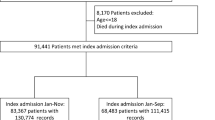Abstract
Background
The relationship of scope of practice (predominantly adult, versus predominantly pediatric) with the outcomes of brain tumor surgery in children remains uncertain. We investigated the association of practice focus with the outcomes of neurosurgical oncology operations in pediatric patients.
Methods
We performed a cohort study of all pediatric patients (younger than 18 years old) who underwent craniotomies for tumor resections from 2009 to 2013 and were registered in the Statewide Planning and Research Cooperative System (SPARCS) database. In order to control for confounding, we used propensity score conditioning with mixed effects analysis to account for clustering at the hospital level.
Results
During the study period, there were 770 pediatric patients who underwent craniotomy for tumor resection and met the inclusion criteria. Of these, 370 (48.1%) underwent treatment by providers with predominantly adult practices and 400 (51.9%) by physicians who operated predominantly on children. Mixed-effects multivariable regression analysis demonstrated lack of association of predominantly adult practice with inpatient mortality (OR, 1.12; 95% CI, 0.48–2.58), and discharge to a facility (OR, 1.25; 95% CI, 0.77–2.03). These associations persisted in propensity-adjusted models.
Conclusions
In a cohort of pediatric patients undergoing craniotomy for tumor resection from a comprehensive all-payer database, we did not demonstrate a difference in mortality, and discharge to a facility between providers with predominantly adult and predominantly pediatric practices.
Similar content being viewed by others
References
Bekelis K, Bakhoum SF, Desai A, Mackenzie TA, Roberts DW (2013) Outcome prediction in intracranial tumor surgery: the National Surgical Quality Improvement Program 2005–2010. J Neurooncol 113:57–64
Bekelis K, Kalakoti P, Nanda A, Missios S (2015) A predictive model of unfavorable outcomes after benign intracranial tumor resection. World Neurosurg 84:82–89
Bekelis K, Missios S, Coy S, MacKenzie TA (2016) Scope of practice and outcomes of cerebrovascular procedures in children. Childs Nerv Syst 32:2159–2164
Dudley RW, Torok MR, Gallegos D, Liu AK, Handler MH, Hankinson TC (2015) Pediatric choroid plexus tumors: epidemiology, treatments, and outcome analysis on 202 children from the SEER database. J Neurooncol 121:201–207
Hankinson TC, Dudley RW, Torok MR, Patibandla MR, Dorris K, Poonia S, Wilkinson CC, Bruny JL, Handler MH, Liu AK (2016) Short-term mortality following surgical procedures for the diagnosis of pediatric brain tumors: outcome analysis in 5533 children from SEER, 2004–2011. J Neurosurg Pediatr 17:289–297
Health NYSDo (2015) Statewide Planning and Research Cooperative System (SPARCS). https://www.health.ny.gov/statistics/sparcs/. Accessed 13 Feb 2015
Hosainey SA, Lassen B, Helseth E, Meling TR (2014) Cerebrospinal fluid disturbances after 381 consecutive craniotomies for intracranial tumors in pediatric patients. J Neurosurg Pediatr 14:604–614
Lassen B, Helseth E, Egge A, Due-Tønnessen BJ, Rønning P, Meling TR (2012) Surgical mortality and selected complications in 273 consecutive craniotomies for intracranial tumors in pediatric patients. Neurosurgery 70:936–943
Lassen B, Helseth E, Rønning P, Scheie D, Johannesen TB, Mæhlen J, Langmoen IA, Meling TR (2011) Surgical mortality at 30 days and complications leading to recraniotomy in 2630 consecutive craniotomies for intracranial tumors. Neurosurgery 68:1259–1268
Missios S, Bekelis K (2015) Drivers of hospitalization cost after craniotomy for tumor resection: creation and validation of a predictive model. BMC Health Serv Res 15:85
Missios S, Bekelis K (2016) Regional disparities in hospitalization charges for patients undergoing craniotomy for tumor resection in New York State: correlation with outcomes. J Neurooncol 128:365–371
Missios S, Kalakoti P, Nanda A, Bekelis K (2015) Craniotomy for glioma resection: a predictive model. World Neurosurg 83:957–964
NeuroPoint Alliance (2015) The National Neurosurgery Quality and Outcomes Database (N2QOD). http://www.neuropoint.org/NPAN2QOD.html. Accessed 15 Jan 2015
Smith ER, Butler WE, Barker FG (2004) Craniotomy for resection of pediatric brain tumors in the United States, 1988 to 2000: effects of provider caseloads and progressive centralization and specialization of care. Neurosurgery 54:553–563
von Lehe M, Kim HJ, Schramm J, Simon M (2013) A comprehensive analysis of early outcomes and complication rates after 769 craniotomies in pediatric patients. Childs Nerv Syst 29:781–790
Williams C, Simon TD, Riva-Cambrin J, Bratton SL (2012) Hyponatremia with intracranial malignant tumor resection in children. J Neurosurg Pediatr 9:524–529
Author information
Authors and Affiliations
Corresponding author
Ethics declarations
Funding
No funding was received for this research.
Conflict of interest
None.
Ethical approval
All procedures performed in studies involving human participants were in accordance with the ethical standards of the institutional research committee and with the 1964 Helsinki Declaration and its later amendments or comparable ethical standards.
Informed consent
For this type of study formal consent is not required.
Electronic supplementary material
Below is the link to the electronic supplementary material.
ESM 1
(DOC 40 kb)
Rights and permissions
About this article
Cite this article
Missios, S., Bekelis, K. Does scope of practice correlate with the outcomes of craniotomy for tumor resection in children?. Acta Neurochir 159, 975–979 (2017). https://doi.org/10.1007/s00701-017-3160-x
Received:
Accepted:
Published:
Issue Date:
DOI: https://doi.org/10.1007/s00701-017-3160-x




